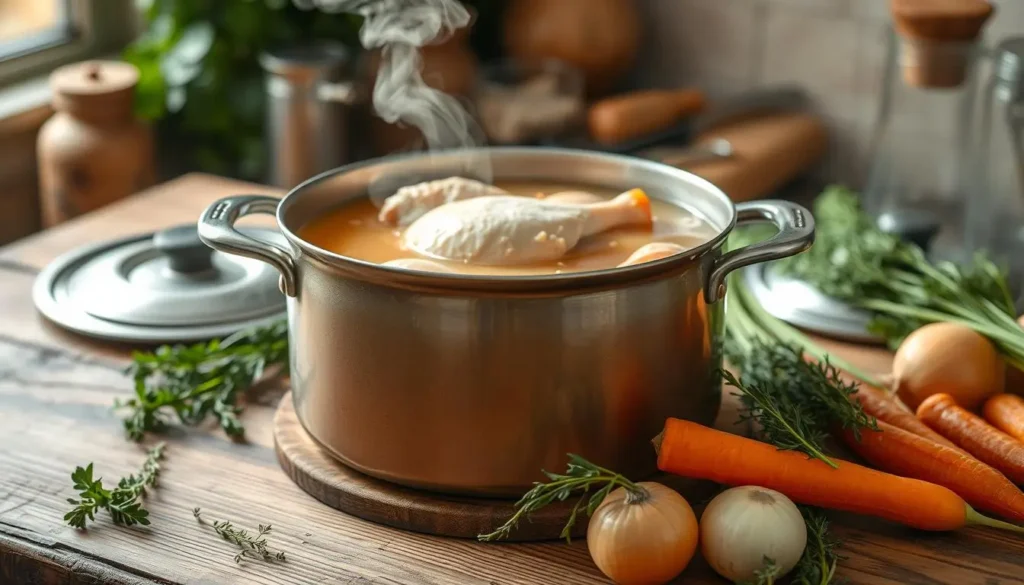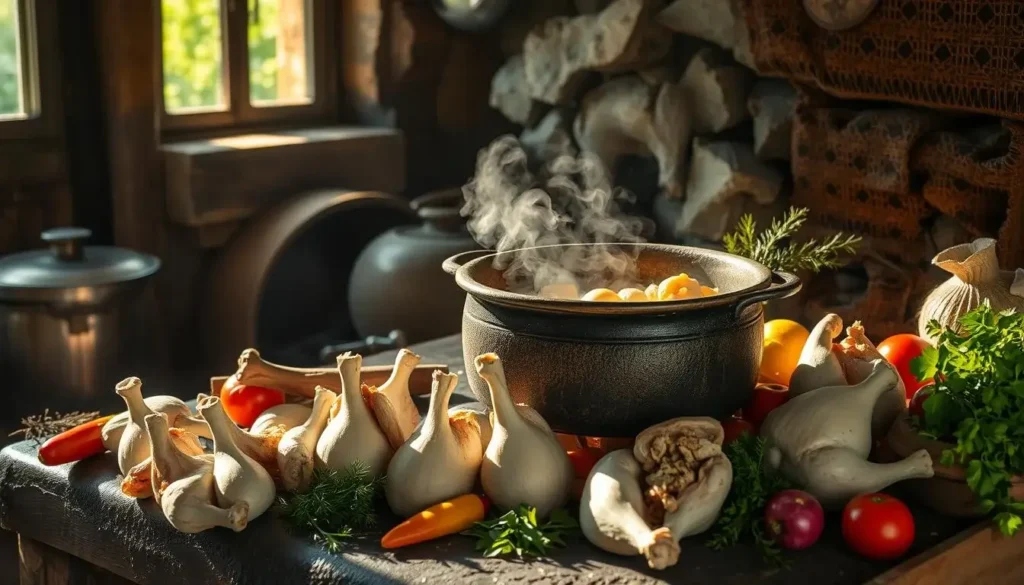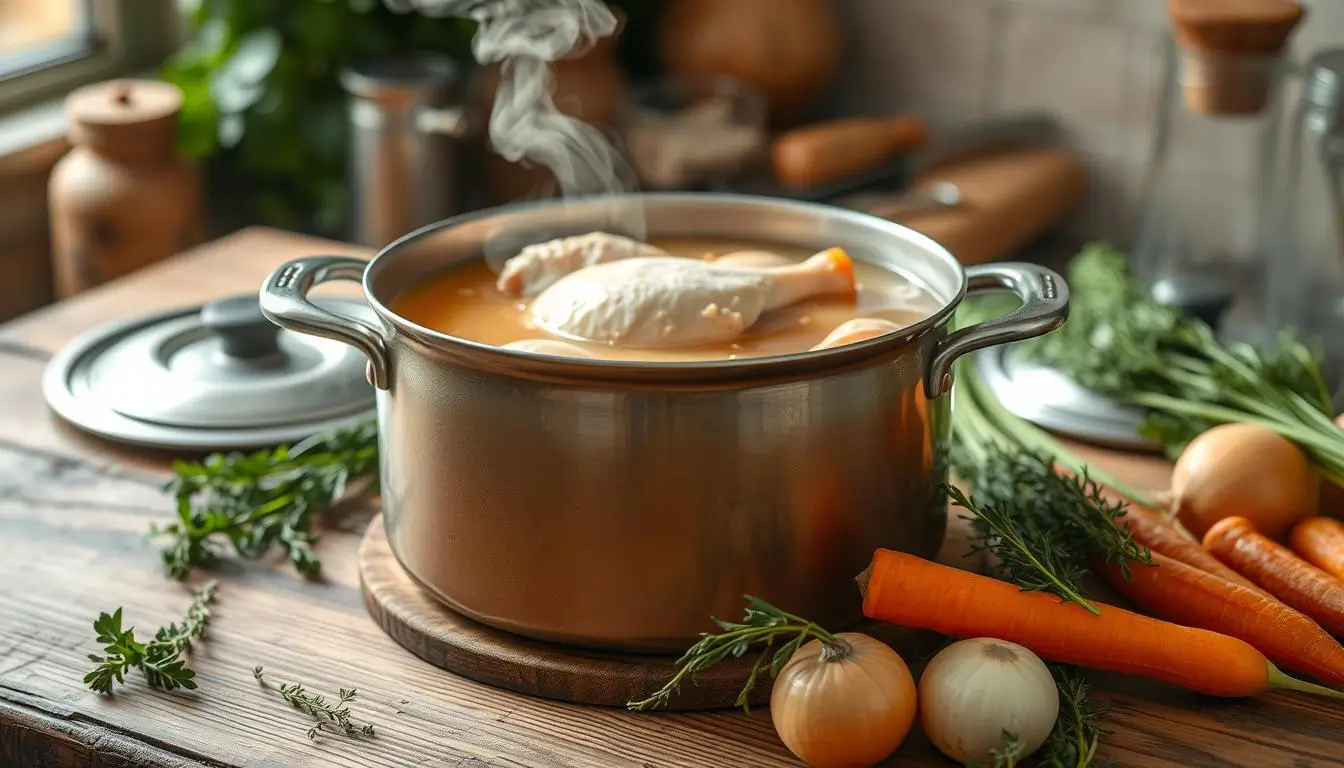Discover how easy it is to make a tasty chicken bone broth at home. Homemade bone broth opens up a world of flavors and health benefits. It’s simple to learn how to make chicken bone broth, adding nutrition to your meals. A good chicken bone broth recipe is key for many dishes, like soups and sauces.

Making your own bone broth lets you control the ingredients and cooking. This ensures you get the best flavor and nutrition. Whether you want a comforting soup or a nutritious base for other recipes, homemade chicken bone broth is perfect. This recipe will teach you how to make chicken bone broth that’s full of flavor and nutrients.
Key Takeaways
- Homemade bone broth is a nutritious and delicious addition to any meal
- Learning how to make chicken bone broth is easy and rewarding
- A good chicken bone broth recipe is the foundation of many dishes
- Making homemade bone broth allows you to control the ingredients and cooking process
- Homemade chicken bone broth is a great way to add flavor and nutrition to your meals
- With this recipe, you can make delicious and nutritious chicken bone broth at home
Table of Contents
The Ancient Art of Making Chicken Bone Broth
Chicken bone broth has been a key part of many cultures for centuries. Its bone broth history goes back to ancient times. It’s valued for its health benefits, making it a key ingredient in traditional bone broth recipes.
The art of making chicken bone broth has been passed down through generations. Each culture has added its own twist to the recipe. In many Asian cultures, bone broth is a staple, loved for its flavor and health benefits.

- Rich in protein and collagen
- High in minerals such as calcium and magnesium
- Supports digestive health and immune function
Exploring the cultural significance of bone broth shows its big role in many cultures. Understanding its bone broth history helps us see its value today. It’s a nourishing liquid that’s still important in our lives.
| Culture | Traditional Use of Bone Broth |
|---|---|
| Chinese | Used in traditional medicine to nourish the body and promote healing |
| European | Used as a base for soups and stews, and as a remedy for colds and flu |
| Asian | Used as a staple in traditional cuisine, and as a ingredient in many dishes |
Health Benefits of Homemade Bone Broth
Homemade bone broth is packed with nutrients that can boost your health. It’s rich in collagen, which is good for your joints and skin. Adding bone broth to your diet can help you feel better overall and strengthen your immune system.
Some of the key bone broth benefits include:
- Supporting gut health through the absorption of essential minerals and amino acids
- Aiding in recovery from illness or injury due to its nutritional value of bone broth
- Providing collagen, which can help improve joint function and skin health
Nutritional value of bone broth is also significant, as it contains a variety of essential minerals and amino acids. The collagen in bone broth is particularly beneficial, as it can help to improve skin elasticity and reduce the appearance of fine lines and wrinkles.

Bone broth is also great as a base for soups and stews. It’s a nutritious and versatile addition to any meal. With its many benefits and high nutritional value, homemade bone broth is a favorite in health-conscious homes.
| Benefit | Description |
|---|---|
| Gut Health | Supports the absorption of essential minerals and amino acids |
| Joint Function | Provides collagen to improve joint health and reduce inflammation |
| Skin Health | Improves skin elasticity and reduces the appearance of fine lines and wrinkles |
Essential Ingredients for the Perfect Chicken Bone Broth Recipe
To make a tasty and healthy chicken bone broth, picking the right bone broth ingredients is key. Start with high-quality chicken bones for broth. You can find these at your local butcher or a trusted supplier. Choose organic and pasture-raised bones for the best taste and nutrients.
Vegetables for bone broth are also crucial. They add flavor and nutrients. Carrots, celery, and onions are great choices. You can also try leeks, garlic, and mushrooms for a unique taste.
Roasting the chicken bones for broth before simmering them is important. It makes the broth richer and more flavorful. With quality chicken bones for broth and a mix of vegetables for bone broth, you’ll get a broth that’s both delicious and nutritious. It’s perfect for sipping or as a base for soups and stews.
Required Equipment and Tools
To make tasty chicken bone broth at home, you need the right bone broth equipment. A big stock pot for bone broth is key for stovetop cooking. On the other hand, a slow cooker bone broth method is easy and hands-off. You might already have most of what you need in your kitchen, making it simple to start.
Here are some important tools to think about:
- A large stock pot (at least 8 quarts) for stovetop cooking
- A slow cooker for hands-off cooking
- A strainer or fine-mesh sieve for straining the broth
- Storage containers for refrigerating or freezing the broth
When picking your bone broth equipment, think about what works best for you. If you like the old-school way, a stock pot for bone broth is perfect. For something easier and modern, slow cooker bone broth is the choice. With the right tools and a bit of practice, you’ll be making great homemade bone broth soon.
Step-by-Step Chicken Bone Broth Recipe
Making delicious and nutritious chicken bone broth is easy. Follow these simple steps to become a bone broth pro quickly.
Cooking bone broth is an art that needs patience and detail. It starts with preparing the bones for better flavor.
Preparation Phase
In this phase, you’ll need to:
- Clean the chicken bones thoroughly
- Roast the bones in the oven to bring out the flavor
- Chop the necessary vegetables and aromatics
Cooking Process
After preparing the ingredients, it’s time to cook. This involves:
- Combining the bones, vegetables, and aromatics in a large pot
- Adding water and bringing the mixture to a boil
- Reducing the heat and letting it simmer for an extended period
Straining and Storing
After cooking, strain the broth and store it. This keeps the flavor and nutrients fresh.
| Storage Method | Shelf Life |
|---|---|
| Refrigeration | 5-7 days |
| Freezing | 3-6 months |
Common Mistakes to Avoid
Making bone broth can be tricky. Troubleshooting bone broth problems can be frustrating. Knowing common mistakes helps you avoid them. One big mistake is not controlling the temperature right. Boiling instead of simmering can make the broth cloudy or greasy.
To make great bone broth, follow some key tips. Here are common mistakes to watch out for:
- Using too many or too few bones, which can affect the flavor and nutritional content of the broth
- Not storing the broth properly, which can lead to contamination and spoilage
- Not skimming the fat and impurities from the surface of the broth, which can make it cloudy and unappetizing
By knowing these mistakes and following bone broth tips, you can make a delicious broth. It’s perfect for soups, stews, and more. Always keep food safety in mind when making and storing bone broth. This way, you’ll avoid mistakes and enjoy a healthy, tasty broth.
| Mistake | Solution |
|---|---|
| Boiling instead of simmering | Reduce heat to a simmer to prevent cloudiness and greasiness |
| Using too many or too few bones | Use the recommended amount of bones for the best flavor and nutritional content |
| Not storing the broth properly | Store the broth in airtight containers in the refrigerator or freezer to prevent contamination and spoilage |
Ways to Use Your Homemade Bone Broth
Now that you have your homemade bone broth, it’s time to explore its uses. You can use it in traditional soups and stews or in new ways. It’s great as a cooking liquid for grains or as a base for sauces.
Using bone broth in your cooking can make your meals better and more nutritious. You can make chicken noodle soup, beef stew, or vegetable soup with it. It’s also good as a base for creamy tomato soup or butternut squash soup. For a clearer broth, strain it and add lemon or herbs for flavor.
Here are some ideas to get you started:
- Use your bone broth as a cooking liquid for grains or legumes
- Add it to your favorite soups or stews for extra flavor and nutrition
- Make a delicious sauce by reducing your bone broth and adding herbs and spices
Remember, the key to enjoying your homemade bone broth is to experiment. Find your favorite ways to use it. Whether drinking it alone or using it in other dishes, it’s full of nutrients. So, get creative and enjoy your homemade bone broth!
Storage Tips and Shelf Life
Storing bone broth right is key to keeping its quality and shelf life. It’s important to use methods that keep its nutrients and taste. Storing it in the fridge is a good way to keep it fresh for a few days.
Freezing bone broth is great for longer storage. It lets you keep it for months, making it easy to always have some on hand. Freezing it in small containers or ice cube trays makes thawing and using it easier.
Refrigeration Methods
To store bone broth in the fridge, cool it down to room temperature first. This stops bacteria from growing and keeps it fresh. Once cooled, put it in an airtight container and store it in the fridge. Bone broth stays good in the fridge for 3 to 5 days.
Freezing Techniques
Freezing bone broth is easy but needs some planning. Before freezing, label and date the containers or ice cube trays. This helps you remember how long it’s been stored. To thaw frozen bone broth, let it thaw in the fridge overnight or thaw it quickly by soaking the container in cold water.
Signs of Spoilage
Always check the bone broth for signs of spoilage before drinking it. If it smells bad, has a slimy texture, or has mold, throw it away. Knowing how to store bone broth helps you enjoy it for longer.
Variations and Flavor Enhancements
Bone broth can be made in many ways. You can add herbs and spices to the basic recipe. For example, thyme and rosemary add a savory taste. Cumin and coriander give it a warm, earthy flavor.
If you want a vegan option, there are choices. Mushroom or seaweed-based broths can replace traditional bone broth. They are just as tasty and healthy.
Here are some ideas for bone broth variations:
- Asian-inspired: Add ginger, lemongrass, and star anise for a flavorful broth.
- Italian-style: Use basil, oregano, and bay leaves for a Mediterranean twist.
- Spicy: Add cayenne pepper or red pepper flakes for a kick.
Trying different bone broth variations is fun and creative. Don’t hesitate to experiment with new ingredients. With practice, you can make a delicious broth that fits your taste.
Whether you prefer traditional or vegan bone broth, there’s a lot to choose from. Exploring different variations lets you create a broth that’s both tasty and meets your dietary needs.
| Broth Type | Ingredients | Flavor Profile |
|---|---|---|
| Chicken Bone Broth | Chicken bones, vegetables, herbs | Rich, savory |
| Vegan Mushroom Broth | Mushrooms, vegetables, herbs | Earthy, umami |
| Spicy Bone Broth | Chicken bones, vegetables, spices | Spicy, aromatic |
Conclusion: Mastering Your Bone Broth Journey
Making homemade bone broth is a rewarding journey. It brings together ancient wisdom and modern benefits. With this chicken bone broth recipe, you can make your own nourishing broth at home.
Mastering bone broth takes patience and practice. Each batch you make will improve your skills and flavor. Enjoy the process, celebrate your successes, and learn from any mistakes. Your homemade bone broth will become a source of pride and nourishment for many meals.
Embrace the bone broth journey for its simple pleasures and benefits. Enjoy the process and let your bone broth bring warmth and vitality to you and your loved ones.
FAQ
What are the key benefits of homemade chicken bone broth?
Homemade chicken bone broth is full of nutrients like collagen and amino acids. It supports gut health and joint function. It also helps with skin health and boosts the immune system.
What are the essential ingredients needed to make the perfect chicken bone broth?
To make great chicken bone broth, you need quality chicken bones. Add vegetables like onions, carrots, and celery. Don’t forget aromatic herbs and spices. You can also use apple cider vinegar or mushrooms for extra flavor.
What equipment and tools are required for making chicken bone broth at home?
You’ll need a big stock pot or slow cooker, a strainer, and containers for storage. A skimmer and ladle can be helpful too.
How do I properly store my homemade chicken bone broth?
Store your homemade chicken bone broth in the fridge for a week or freeze it for months. Cool it fast and use airtight containers. Check for spoilage signs like bad smell or color change before drinking.
Can I customize the flavor of my chicken bone broth?
Yes, you can change the flavor of your chicken bone broth. Try ginger, lemongrass, or star anise for an Asian twist. Or mix different herbs and spices. You can also make it low-sodium or vegan.
- Visit our Instagram page

